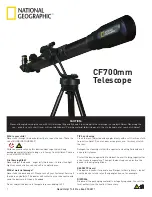
However, the instrument should NEVER be subjected to shock due to being dropped. Mis-
handling of the filters system will cause the etalon to de-contact (not covered under warranty) and
will render the instrument useless until repaired.
As with any precision optical instrument it should be kept in as low a humidity area as possible.
With proper handling and care the filter should last a lifetime.
Cleaning
As with most telescopes and equipment there will be a build up of dust and debris on the lens and
mechanical components after sitting out all day.
For those who are familiar with cleaning telescopes we recommend you use the same
techniques.
For those who are new to the care of these instruments we can offer the following guidelines.
•
Blow off loose dust and dirt using a clean dry air source at low volume. Do NOT use
shop compressed air, which contains oil and will further contaminate the instrument.
•
Stubborn particulates can be brushed from the surface with a static free lens brush. Use
gentle sweeping motions.
•
Fingerprints and smudges can be removed using lens tissue or a Kleenex type tissue
product. Fold the tissue or cloth to make a "pad", apply a cleaning product to the end of
the pad dampening it evenly (do not apply solution to the lens), wipe in circular motion
starting at the center and working around the edge and off in one complete motion. Be
firm, but do NOT rub. Blow lightly to help remove residual solution before it "spots" the
surface. Residual dust from the cloth can be blown off.
•
Consult your local dealer or call Lunt Solar Systems with any questions or concerns.
•
Do NOT use Acetone or strong degreaser type products, household cleaning agents,
paper towels, tissues with added scent or color (plain tissues only), or bleach or acidic
products which will damage the anodized surfaces.
What am I looking at?
The Sun is active on a daily basis. During solar maximum the Sun will put on awe inspiring
displays that include x-class flares, prominences, surface filaments, etc…
Here is a brief overview of those terms, which will help the observer explain what they have seen.
•
Prominences: These look like eruptions from the disk (edge) of the Sun. Prominences
can be small spiky looking details, or large cloud like detail with fine feather like internal
features. They are, in fact, Ionized hydrogen emissions being projected from the limb.
Prominences are anchored to the Sun's surface in the mesosphere, and extend
outwards into the Sun's troposphere.
•
Filaments: These are string like features on the surface of the Sun. At high resolution
they take on a 3D effect due to the cooler aspect of the filament contrasted against the
bright, hotter, Sun. They are actually prominences being viewed against the surface.
•
Spicules: A spicule is a dynamic jet of about 500km diameter on the Sun. It moves
upwards at about 20 km/s from the photosphere. Father Angelo Secchi of the Vatican
Observatory in Rome discovered them in 1877. The chromosphere is entirely
composed of spicules. These features can be seen as "fur" around the edge of the disk.
•
Plage: This is a bright region in the chromosphere of the Sun, typically found in regions
of the chromosphere near sunspots. The plage regions map closely to the faculae in the
photosphere below, but the latter have much smaller spatial scales. Accordingly plage
occurs most visibly near a sunspot region. Faculae have a strong influence on the solar
constant, and the more readily detectable because chromospheric plage areas
!
2
Lunt Solar Systems * 2520 N. Coyote Dr. #111 Tucson, AZ 85745 * 520-344-7348
www.luntsolarsystems.com

















